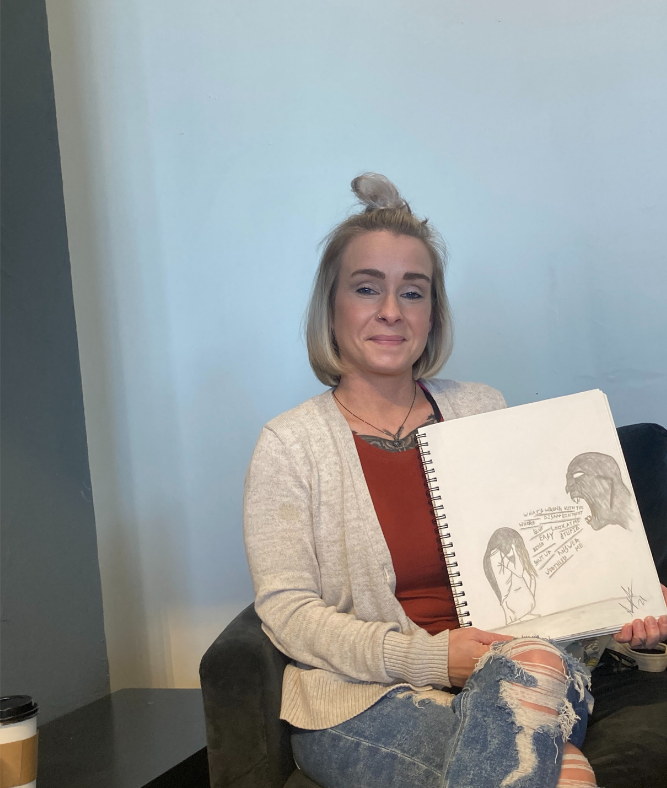On an unseasonably warm winter afternoon at a Tyler coffee shop, Stephanie Glover slid her drawing pad across the table. The page opened to her untitled work featuring two penciled figures profiled on either end of the page. The dark subject stood in contrast to the bright sunshine outside.

A girl crouches in fear on the left, her long, dark hair obscuring her age and identity. On the other side, a large, disembodied head looms over her. Glover’s line is sharp, in contrast to the girl. Jagged teeth protrude from his gaping jaw. He squints with rage. Shooting from his mouth are words and phrases written in biting, jagged script: “worthless,” “whore,” “slut,” “What’s wrong with you?”
The girl’s fearful posture reveals her anguish; her assailant, through his disembodied form, appears untouchable and more monster than human.
Glover grew up in Tyler, attended John Tyler High School and recently graduated with a master’s degree in psychology from LaTourneau University in Longview. Glover said she channeled some of the energy she had from traumatic experiences.
She continues to use drawing as a “release” when she “…couldn’t channel [her own] feelings” or “didn’t know how to identify them.”


Her untitled work recalls when Glover was 17 and assaulted twice in one weekend by a friend. It was August of her senior year in high school.
She woke up the next morning on her parents’ doorstep. “I knew something was wrong. I knew something happened to me,” she said.
She sought help from her parents, but received a barrage of blame akin to the words in her drawing instead. Glover next reached out to a trusted teacher. “I told him what happened and I was crying,” Glover recalled. “And instead of helping me, he kissed me on the lips.”
She kept quiet after that.
Feeling alone, Glover embraced drinking and drugs.
“I shoved [my feelings] down with cocaine, with pills, with alcohol, with weed, whatever I could to numb it,” she said.
Shortly after graduation, Stephanie met and married her husband. During their first year, she developed an eating disorder. By the time she was pregnant with her third child, she was in recovery from both substance abuse and the disordered eating.
Glover said when troubles arose in her marriage, she knew she couldn’t return to substances or disordered eating to cope. “I don’t have alcohol anymore. I don’t have an eating disorder anymore. I don’t have drugs anymore. What am I going to do?” she recalled asking herself.
Glover began experiencing “emotional flashbacks” from unprocessed trauma, along with nightmares, anxiety and tremors, although nearly two decades had passed. “You don’t have to remember something. You can just feel it…my body still remembers,” she explained.
“It happened to me when I was 17, but I’m 35 and I’m still experiencing it.”

Through therapy, Glover said she rediscovered creative drawing as a healthy coping mechanism as well as “…a lot of inner child work…a lot of reparenting.” Through meditation, she could embrace her inner child and to tell her younger self that they’re safe now. When old emotions stir, Glover said she “can mentally tell [her] inner child… ‘We’re okay right now.’”
Glover said her untitled piece may cause other survivors of sexual and verbal assault to feel the weight of abuse, but she wants them to know the words spewing from the head are untrue.

“It’s not true…the feelings are real,” she said. “The things you’re feeling are valid. The hurt is valid.
The pain is valid, but these words are not true.”
Rachel Neal is an enthusiast of all things fine arts. She studies English at the University of Texas at Tyler.
Love what you're seeing in our posts? Help power our local, nonprofit journalism platform — from in-depth reads, to freelance training, to COVID Stories videos, to intimate portraits of East Texans through storytelling.
Our readers have told us they want to better understand this place we all call home, from Tyler's north-south divide to our city's changing demographics. What systemic issues need attention? What are are greatest concerns and hopes? What matters most to Tylerites and East Texans?
Help us create more informed, more connected, more engaged Tyler. Help us continue providing no paywall, free access posts. Become a member today. Your $15/month contribution drives our work.







